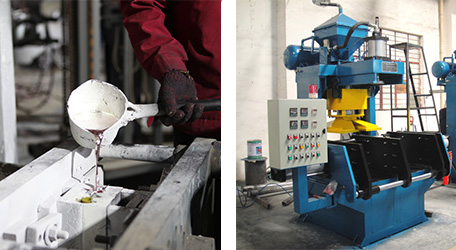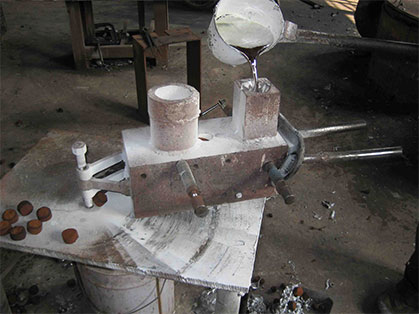It is well known that investment casting produces castings with high precision and good finish. However, many common casting defects may exist during the production process of investment casting. Based on our engineering experience and advanced equipment, we can find ways to prevent such problems by analyzing the causes.
In the following, we introduce several common casting defects and their causes and prevention methods. We hope this article helps our customers to understand the problem and our colleagues, and this analysis can help you to prevent possible casting defects.
Bottom casting and cold barrier
1、Problem description.
Bottom casting is often in the casting thin wall or away from the inner runner at the local lack of flesh, the edge is curved. Cold barrier is the two strands of molten metal are not completely fused, there is a clear joint.
2. Causes.
1) low metal liquid pouring temperature and mold temperature
2) Slow pouring speed or unreasonable setting of flow channel, metal flow is too long
3) Casting wall thickness is too thin, metal liquid flow is not good
4) cut off when pouring
3. Preventive measures.
1) Increase the pouring temperature of metal liquid and mold temperature
2) Increase the pouring speed or increase the number or area of the inner runner to reduce the flow of metal liquid
3) Increase the pressure head of the pouring riser to prevent cut-off during pouring
Shrinkage
1、Problem description.
It can only be found by X-ray inspection. Surface shrinkage can be found by fluorescence or staining inspection. Severe cases can be found after sand blowing.
2、Cause.
(1) casting structure is unreasonable, too many hot spots or too large
2) small heat capacity of the sprue, failure to form sequential solidification, or small pressure head, lower
3) Low mold temperature, fast cooling rate, replenishment channel blockage 3.
Preventive measures.
1) improve casting organization, reduce hot spots
2) Reasonable setting of the riser, or increase the reinforcement bars that can be removed by processing methods, increase the pressure head, so that the molten die castings in a certain pressure head under the action of sequential solidification
3) Properly increase the pouring temperature and mold temperature to reduce the cooling rate

Thermal cracking
1、Problem description.
Irregular intergranular cracks on the surface or inside, surface oxidation. Visible after severe sand clearing, only light processing or penetration check can be found.
2、Cause of generation.
(1) related to the alloy composition, high carbon and silicon content, liquid-solid phase temperature range, easy to thermal cracking
(2) mold temperature is low, poor reprocessability and fast cooling rate
(3) the thickness of the casting varies greatly, the transition rounding is too small
3. Preventive measures.
1) The alloy or steel prone to thermal cracking, its carbon and silicon content should be controlled in the lower limit as much as possible
2) increase the mold temperature when pouring, slow down the cooling rate of the casting, or reduce the strength of the mold shell
3) Increase the anti-cracking process tendons at the thick and thin joints of the casting, or increase the transition rounding
Cold cracking
Name and characteristics.
There is a continuous penetrating crack on the casting. The fracture appears shiny or slightly oxidized surface.
Cause
1、Castings in the cooling process, shrinkage is blocked, resulting in thermal stress and phase change stress, these stresses exceed the strength of the material in the elastic state and cause fracture.
2、In the process of shell cleaning, gate cutting, riser or adjustment, the castings with residual stress are subjected to external force and cause fracture.
Prevention methods
1、Increase the reinforcement at the cold crack to improve the retractability of the profile, thus reducing the shrinkage resistance and casting stress.
2、During the post-casting process, avoid the violent impact between the castings.

Pore
Name and characteristics
There are obvious or inconspicuous pores on the casting, with smooth inner surface.
Cause
1、Poor permeability of the mold shell, and the gas in the cavity is not discharged in time when casting.
2、Insufficient shell firing, resulting in inadequate removal of mold material residues and gas-producing materials in the shell material.
3、The metal liquid gas content is too high and the deoxidation is not good.
4、Irrational setting of pouring system, resulting in pouring involving popularity.
Prevention methods
1、Improve the air permeability of the shell, and increase the ventilation holes if necessary.
2. Completely fired shell.
3、Improve deoxygenation method.
4、Improve the pouring system.
In order to ensure the processing quality of alloy cast steel parts, generally have strict requirements when we cast it, but in the process of casting there are still we need to pay attention to, generally need to pay attention to what? This article gives you an introduction.
1、Temperature
The temperature has a great influence on the quality of the casting, it should be determined according to the alloy type, casting structure and casting characteristics to determine a reasonable casting temperature range. According to the type of carbon steel to choose a reasonable casting temperature, the general casting temperature in 1540-1580 ℃, pouring ladle steel temperature between.
2、Speed
As far as casting speed is concerned, under the condition of ensuring smooth gas discharge in the cavity, higher casting speed can be used for castings requiring simultaneous solidification, and lower casting speed can be used as far as possible for castings requiring sequential solidification.
3、Operation requirements
We would like to remind you that the operation requirements can never be sloppy and generally need to comply with the following 2 points.
(1) Casting large and medium-sized alloy cast steel parts, the steel should be cast after 1-2min sedation in the ladle.
(2) after casting to be cast solidification is completed, to remove the pressure iron and box card in time to reduce the casting shrinkage resistance, to avoid cracking defects in the casting.
ZheJiang Dongrun Casting Industry Co,.Ltd was built in 1995, We have been in the casting industry for more than 25 years. No matter what type of molding you need done, we are the right supplier for your jobs. Unlike other of our competition, we offer four types of castings.
Dongrun Casting have 20000 square meters facility houses and 200 production & test equipment, From quotation and tooling design to casting and finished machining, we can work with you at every stage. We serves wide range of industries-from Fortune 500 corporations to small and midsize OEMs. Our products includes:
❖ HVAC | ❖ Architectural parts |
Browse our online showroom to see what we can do for you. And then E-mail:dongrun@dongruncasting.com us your specifications or inquiries today
